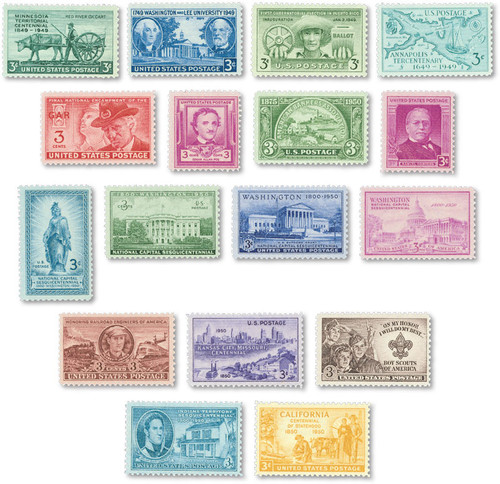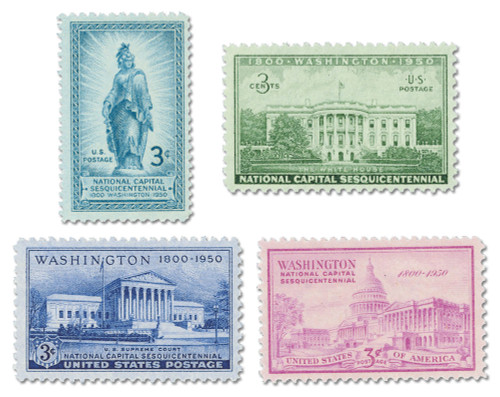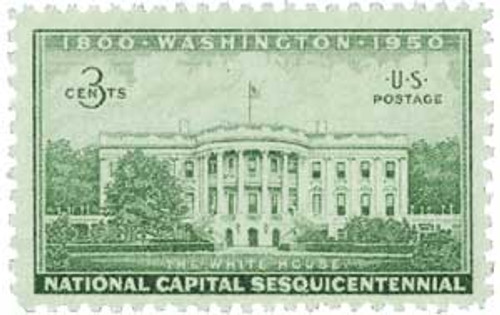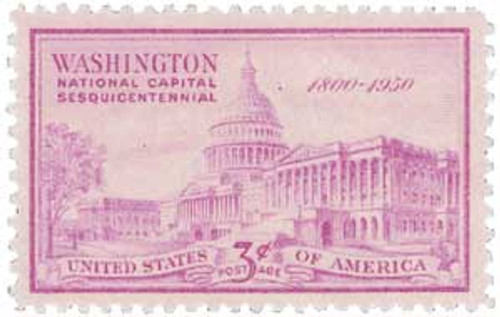
1950 3c National Capitol Sesquicentennial: Supreme Court Building
# 991 - 1950 3c National Capitol Sesquicentennial: Supreme Court Building
$0.35 - $22.50
U.S. #991
1950 3¢ Supreme Court Building
National Capital Sesquicentennial Issue
Issue Date: August 2, 1950
City: Washington, D.C.
Quantity: 131,350,000
Printed By: Bureau of Engraving and Printing
Printing Method: Rotary Press
Perforations: 10 ½ x 11
Color: Light violet
U.S. #991 is part of a four-stamp set to honor the 150th anniversary of the nation's capital. The stamp pictures the U.S. Supreme Court Building to illustrate the Judicial branch of government. The building was completed in 1935. Before then, the Supreme Court met in various parts of the U.S. Capitol building.
National Capital Sesquicentennial
A set of four U.S. stamps was issued in 1950 in honor of the 150th anniversary of the establishment of Washington, D.C., as the nation's capital. The stamps portrayed the three branches of government (Executive, Judicial, Legislative), as well as the concepts of Liberty and Freedom.
The idea that the capital be a district that was not part of any state was first put forth by James Madison, in Essay No. 43 of the Federalist Papers. The Compromise of 1790 resulted in the federal government assuming the war debt of the individual states in return for the placement of the national capital in the South.
A provision in the U.S. Constitution allowed for an area like a square of 10-mile sides. The land was donated by both Maryland and Virginia. The City of Washington and the Territory of Columbia were originally two separate entities, but in 1801, both the territory and the city (as well as neighboring cities Georgetown and Alexandria) were placed under the direct control of Congress. The federal government officially moved into the District in 1800.
U.S. #991
1950 3¢ Supreme Court Building
National Capital Sesquicentennial Issue
Issue Date: August 2, 1950
City: Washington, D.C.
Quantity: 131,350,000
Printed By: Bureau of Engraving and Printing
Printing Method: Rotary Press
Perforations: 10 ½ x 11
Color: Light violet
U.S. #991 is part of a four-stamp set to honor the 150th anniversary of the nation's capital. The stamp pictures the U.S. Supreme Court Building to illustrate the Judicial branch of government. The building was completed in 1935. Before then, the Supreme Court met in various parts of the U.S. Capitol building.
National Capital Sesquicentennial
A set of four U.S. stamps was issued in 1950 in honor of the 150th anniversary of the establishment of Washington, D.C., as the nation's capital. The stamps portrayed the three branches of government (Executive, Judicial, Legislative), as well as the concepts of Liberty and Freedom.
The idea that the capital be a district that was not part of any state was first put forth by James Madison, in Essay No. 43 of the Federalist Papers. The Compromise of 1790 resulted in the federal government assuming the war debt of the individual states in return for the placement of the national capital in the South.
A provision in the U.S. Constitution allowed for an area like a square of 10-mile sides. The land was donated by both Maryland and Virginia. The City of Washington and the Territory of Columbia were originally two separate entities, but in 1801, both the territory and the city (as well as neighboring cities Georgetown and Alexandria) were placed under the direct control of Congress. The federal government officially moved into the District in 1800.












